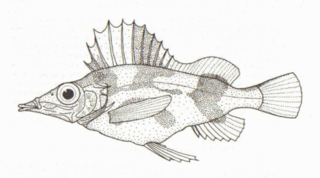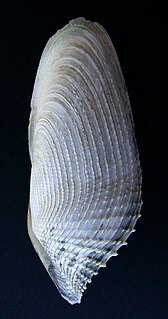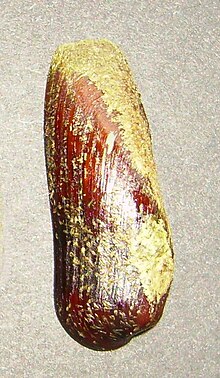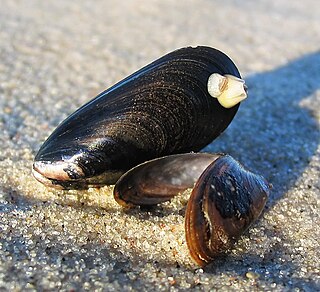Deania is a genus of long-snouted, deepwater dogfish sharks in the family Centrophoridae.

The New Zealand topknot, Notoclinus fenestratus, is a triplefin of the genus Notoclinus, found around the North Island of New Zealand in reef areas of broken rock and brown seaweed.

The New Zealand black angelfish or the black scalyfin, Parma alboscapularis, is a damselfish of the family Pomacentridae, found around northeastern New Zealand to depths of a few metres, over shallow rocky reef areas. Its length is between 24 and 28 cm.
The New Zealand rockfish, Acanthoclinus littoreus, is a roundhead of the genus Acanthoclinus, found only in New Zealand from shallow depths to 15 m. Their length is between 5 and 15 cm.
The notchheaded marblefish, Aplodactylus etheridgii, is a marblefish of the genus Aplodactylus, found between North Cape and East Cape in the North Island of New Zealand, in depths down to 40 m. Their lengths are between 35 and 40 cm.
Bruun's cutthroat eel, Histiobranchus bruuni, is a cutthroat eel of the genus Histiobranchus, found around New Zealand at the bottom of the deep ocean basin at depths of between 4,000 and 5,000 m. Their length is between 40 and 60 cm.

The alert pigfish, Alertichthys blacki, is a pigfish, the only species in the genus Alertichthys, found around New Zealand at depths between 100 and 600 m. It is between 15 and 20 cm in length.
The rough-head whiptail or oblique banded rattail, Coelorinchus aspercephalus, is a species of rattail found around New Zealand including islands to New Zealand's south, at depths of between 30 and 300 m. Its length is between 15 and 35 cm.

The New Zealand sole or common sole, Peltorhamphus novaezeelandiae, is a righteye flounder of the genus Peltorhamphus, found around New Zealand in shallow enclosed waters less than 100 m in depth. Their length is from 25 to 45 cm.

The longnose spurdog is a dogfish shark of the genus Squalus, found over continental shelves in all oceans, at depths of between 15 and 800 metres. They reach one metre in length.

The New Zealand turbot, Colistium nudipinnis, is a righteye flounder of the subfamily Rhombosoleinae in the family Pleuronectidae, found around New Zealand in shallow enclosed waters. Their length is from 25 to 90 cm, and they are the largest flounder in New Zealand.
The scaly gurnard, Lepidotrigla brachyoptera, is a searobin of the family Triglidae, found around New Zealand including the Kermadec Islands, at depths of between 35 and 300 m. Its length is up to 15 cm.

The giant stargazer, Kathetostoma giganteum, is a stargazer of the family Uranoscopidae, found on the continental shelf around New Zealand and endemic to that area.
Crapatalus angusticeps, the slender stargazer, is a species of southern sandfish endemic to the Pacific waters around New Zealand. It can be found at depths between a few and 60 m.
The New Zealand flathead, Bembrops morelandi, is a duckbill of the family Percophidae, subfamily Bembropinae, found only around New Zealand, at depths between 365 and 395 m. Their length is up to 20 cm.
Paphies is a genus of large, edible, saltwater clams, marine bivalve molluscs in the family Mesodesmatidae. The genus is endemic to New Zealand. The species in this genus include the pipi, tuatua and toheroa.
Nucula hartvigiana is a saltwater nut clam, a marine bivalve mollusc in the family Nuculidae.

Mactra ovata is a trough shell of the family Mactridae.

Onchidella nigricans is a species of small, air-breathing sea slug, a shell-less marine pulmonate gastropod mollusc in the family Onchidiidae.

Barnea similis, a rock borer or piddock, is a marine bivalve mollusc in the family Pholadidae.
HarperCollins Publishers L.L.C. is one of the world's largest publishing companies and is one of the Big Five English-language publishing companies, alongside Hachette, Macmillan, Penguin Random House, and Simon & Schuster. The company is headquartered in New York City and is a subsidiary of News Corp. The name is a combination of several publishing firm names: Harper & Row, an American publishing company acquired in 1987, together with UK publishing company William Collins, Sons, acquired in 1990.
Arthur William Baden Powell was a New Zealand malacologist, naturalist and palaeontologist, a major influence in the study and classification of New Zealand molluscs through much of the 20th century. He was known to his friends and family by his third name, "Baden".

The International Standard Book Number (ISBN) is a numeric commercial book identifier which is intended to be unique. Publishers purchase ISBNs from an affiliate of the International ISBN Agency.














